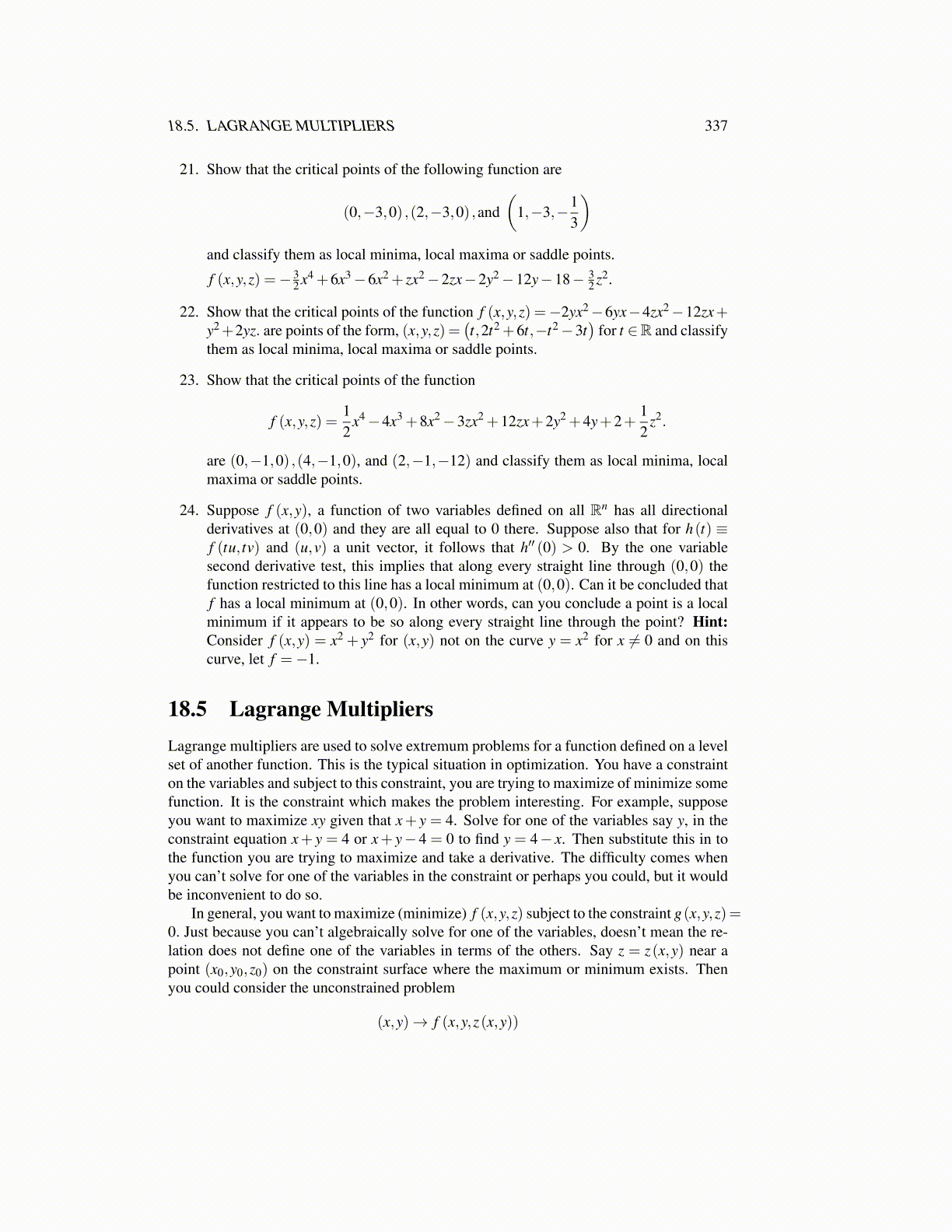
18.5. LAGRANGE MULTIPLIERS 337
21. Show that the critical points of the following function are
(0,−3,0) ,(2,−3,0) ,and(
1,−3,−13
)and classify them as local minima, local maxima or saddle points.
f (x,y,z) =− 32 x4 +6x3−6x2 + zx2−2zx−2y2−12y−18− 3
2 z2.
22. Show that the critical points of the function f (x,y,z) =−2yx2−6yx−4zx2−12zx+y2+2yz. are points of the form, (x,y,z) =
(t,2t2 +6t,−t2−3t
)for t ∈R and classify
them as local minima, local maxima or saddle points.
23. Show that the critical points of the function
f (x,y,z) =12
x4−4x3 +8x2−3zx2 +12zx+2y2 +4y+2+12
z2.
are (0,−1,0) ,(4,−1,0), and (2,−1,−12) and classify them as local minima, localmaxima or saddle points.
24. Suppose f (x,y), a function of two variables defined on all Rn has all directionalderivatives at (0,0) and they are all equal to 0 there. Suppose also that for h(t) ≡f (tu, tv) and (u,v) a unit vector, it follows that h′′ (0) > 0. By the one variablesecond derivative test, this implies that along every straight line through (0,0) thefunction restricted to this line has a local minimum at (0,0). Can it be concluded thatf has a local minimum at (0,0). In other words, can you conclude a point is a localminimum if it appears to be so along every straight line through the point? Hint:Consider f (x,y) = x2 + y2 for (x,y) not on the curve y = x2 for x ̸= 0 and on thiscurve, let f =−1.
18.5 Lagrange MultipliersLagrange multipliers are used to solve extremum problems for a function defined on a levelset of another function. This is the typical situation in optimization. You have a constrainton the variables and subject to this constraint, you are trying to maximize of minimize somefunction. It is the constraint which makes the problem interesting. For example, supposeyou want to maximize xy given that x+ y = 4. Solve for one of the variables say y, in theconstraint equation x+ y = 4 or x+ y− 4 = 0 to find y = 4− x. Then substitute this in tothe function you are trying to maximize and take a derivative. The difficulty comes whenyou can’t solve for one of the variables in the constraint or perhaps you could, but it wouldbe inconvenient to do so.
In general, you want to maximize (minimize) f (x,y,z) subject to the constraint g(x,y,z)=0. Just because you can’t algebraically solve for one of the variables, doesn’t mean the re-lation does not define one of the variables in terms of the others. Say z = z(x,y) near apoint (x0,y0,z0) on the constraint surface where the maximum or minimum exists. Thenyou could consider the unconstrained problem
(x,y)→ f (x,y,z(x,y))